Simon Bening
Simon Bening (c. 1483 – 1561) was a Flemish miniaturist, generally regarded as the last major artist of the Netherlandish tradition.[2]


Bening, born either in Ghent or Antwerp, was probably trained by his father, illuminator Alexander Bening, in the family workshop in Ghent. He travelled between Ghent and Bruges and became a member of the guild of San John and Saint Luke in Bruges as an illuminator in 1508. He made his own name after moving to Bruges in about 1510, where he had lived since. From 1517 to 1555 he is listed regularly in the guild's annual accounts. Bening served as a dean of the calligraphers, booksellers, illuminators and bookbinders in the Guild of Saint John and Saint Luke three separate times (1524, 1536, 1546).[3]
He was married twice and had six daughters. Two of them continued the family artistic tradition: Levina Teerlinc became a miniature painter, mostly of portrait miniatures, and emigrated to England, and Alexandrine Claeiszuene became a successful art dealer.[4]
Works
Bening specialised in book of hours, but by his time these were produced only for royal or very rich patrons. He also created genealogical tables and portable altarpieces on parchment. Many of his finest works are Labours of the Months for books of Hours which are largely small scale landscapes, at that time a nascent genre of painting. In other respects his style is relatively little developed beyond that of the years before his birth, but his landscapes serve as a link between the 15th century illuminators and Peter Brueghel. His self-portrait and other portraits equally are early examples of the portrait miniature.
He produced books for German rulers, like Cardinal Albrecht of Brandenburg, and royalty like Emperor Charles V and Don Fernando, the Infante of Portugal. Robert de Clercq, abbot of the Cistercian monastery of Ter Duinen ("Les Dunes") at Koksijde, near Bruges, commissioned a Benedictional from him sometime between 1519 and 1529. Bening portrayed the abbot in a colourful Crucifixion scene.[5]
Selected Works
- Labours of the Months
- Munich-Montserrat Book of Hours
- Codex of the Order of the Golden Fleece, Patrimonio Nacional, Spain.
Gallery
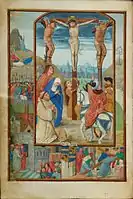 Benedictional of Robert de Clercq: Crucifixion, f. 4v, Cambridge University Library, Cambridge
Benedictional of Robert de Clercq: Crucifixion, f. 4v, Cambridge University Library, Cambridge Prayer Book of Cardinal Albrecht of Brandenburg: text page with decorated borders, f 124, J. Paul Getty Museum, Los Angeles
Prayer Book of Cardinal Albrecht of Brandenburg: text page with decorated borders, f 124, J. Paul Getty Museum, Los Angeles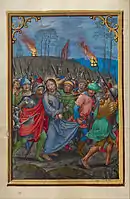 Prayer Book of Cardinal Albrecht of Brandenburg: The Arrest of Christ, f 107v, J. Paul Getty Museum, Los Angeles
Prayer Book of Cardinal Albrecht of Brandenburg: The Arrest of Christ, f 107v, J. Paul Getty Museum, Los Angeles%252C_f.27r_-_BL_Add_MS_24098.jpg.webp) Four men playing a game that resembles golf. The Golf book, British Library
Four men playing a game that resembles golf. The Golf book, British Library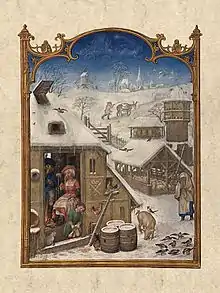 February, Breviarium Grimaldi (1515–1520), Biblioteca Nazionale Marciana, Venice (Italy)
February, Breviarium Grimaldi (1515–1520), Biblioteca Nazionale Marciana, Venice (Italy) Labors of the Months: April, from a book of hours
Labors of the Months: April, from a book of hours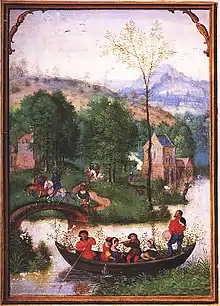 Labors of the Months: May
Labors of the Months: May Labors of the Months: June
Labors of the Months: June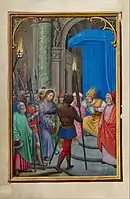 Christ before Caiaphas
Christ before Caiaphas Virgin and Child
Virgin and Child.jpg.webp) Phillip II as The grand master of the order. Codex of the Golden Fleece Order 1536. Patrimonio Nacional, Madrid, Spain.
Phillip II as The grand master of the order. Codex of the Golden Fleece Order 1536. Patrimonio Nacional, Madrid, Spain. Tripthyc of St. Jerome, tempera on parchment adhered to panel. Monastery of El Escorial, Madrid.
Tripthyc of St. Jerome, tempera on parchment adhered to panel. Monastery of El Escorial, Madrid.
References
- Hindman (1997), 112
- Morrison and Kren (2006), 68
- "Simon Bening biography". Getty Museum. Retrieved 18 December 2012.
- Hindman (1997), 98
- "Benedictional of Robert de Clercq". Cambridge Digital Library. Retrieved 18 December 2012.
Sources
- Hindman, Sandra et al. Illuminations in the Robert Lehman Collection. New York: The Metropolitan Museum of Art, 1997.
- Morrison, Elizabeth and Kren, Thomas (eds). Flemish Manuscript Painting in Context. Los Angeles: J. Paul Getty Trust, 2006. ISBN 978-0-89236-852-5
External links
 Media related to Simon Bening at Wikimedia Commons
Media related to Simon Bening at Wikimedia Commons- Gerard David: Purity of Vision in an Age of Transition, exhibition catalog from The Metropolitan Museum of Art (fully available online as PDF)
- The Hennessy Book of Hours, c. 1530–1540
- The Golf Book, c. 1540
- Book of Hours, c. 1525, from the collection at Waddesdon Manor
- Grimani Breviary: a Remarkable Artistic Collaboration between Simon Bening and Other Artists